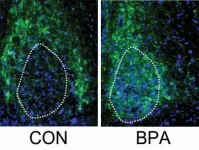The secret lives of Canada lynx
New technology captures never-before-heard sounds of lynx hunting, fighting, and sleeping
2021-06-01
(Press-News.org) Using a Fitbit and a spy mic, scientists have discovered new insight into the behaviour of the elusive Canada lynx. A new study by researchers from McGill University, University of Alberta, and Trent University provides a first look at how miniaturized technology can open the door to remote wildlife monitoring.
"Working on one of the boreal forest's top predators, the Canada lynx, we found that two different technologies, accelerometers and audio recording devices, can be used to remotely monitor the hunting behaviour of predators, even documenting the killing of small prey," says lead author Emily Studd, a Postdoctoral Fellow under the supervision of Murray Humphries at McGill University and Stan Boutin at University of Alberta.
"We captured chases, screams of the prey as they were caught, calls of the prey as they escaped, and bones crunching, along with friendly and aggressive interactions between different lynx," says Studd. Hear the recordings in Studd's recent CBC interview.
"A lot of people want to know what wild animals do when we can't see them. The ability to continuously record their movements and sounds in their natural environment can provide insight into mating rituals, parental care, social interactions - even how individuals differ from one another or change over time," says co-author Allyson Menzies, a recent PhD graduate at McGill University.
According to the researchers, understanding the hunting behaviour of predators is key information for ecologists, providing insight into the wellbeing of an ecosystem.
"Unfortunately, predators are naturally secretive animals due to their need to sneak up on their prey, which makes studying them and recording this information incredibly difficult," explains Studd. Their use of accelerometers and audio recorders provide two new, highly effective methods that can be applied to any predator to monitor behaviour and collect information.
INFORMATION:
About the study
"The Purr?fect Catch: Using accelerometers and audio recorders to document kill rates and hunting behaviour of a small prey specialist," by Emily K. Studd, Rachael E. Derbyshire, Allyson K. Menzies, John F. Simms, Murray M. Humphries, Dennis L. Murray, and Stan Boutin was published in Methods in Ecology and Evolution. This research is part of the Kluane Canada lynx project. Funding was provided for this project by the Natural Sciences and Engineering Research Council, the Weston Family Foundation, and Institut Nordique du Québec.
DOI: https://doi.org/10.1111/2041-210X.13605
About McGill University
Founded in 1821, McGill University is home to exceptional students, faculty, and staff from across Canada and around the world. It is consistently ranked as one of the top universities, both nationally and internationally. It is a world-renowned institution of higher learning with research activities spanning two campuses, 11 faculties, 13 professional schools, 300 programs of study and over 40,000 students, including more than 10,200 graduate students.
McGill's commitment to sustainability reaches back several decades and spans scales from local to global. The sustainability declarations that we have signed affirm our role in helping to shape a future where people and the planet can flourish.
https://www.mcgill.ca/newsroom/
[Attachments] See images for this press release:

ELSE PRESS RELEASES FROM THIS DATE:
2021-06-01
The University of Ottawa's Positive Energy program released new survey results showing that a large segment of the Canadian public does not trust the courts to settle disputes over energy projects or climate policy. The survey was conducted by Positive Energy's official pollster, Nanos Research.
Canadians were asked: On a scale of 0 to 10, where 0 means do not trust at all and 10 means trust completely, how much do you trust the courts to settle disputes over government decisions on energy projects? They were asked the same question for climate policy. The results are very similar. Only one in three Canadians trust the courts to settle disputes over energy projects or climate policy (answering between 7 and 10: 31% for energy, 30% for ...
2021-06-01
Machine learning, when used in climate science builds an actual understanding of the climate system, according to a study published in the journal Chaos by Manuel Santos Gutiérrez and Valerio Lucarini, University of Reading, UK, Mickäel Chekroun, the Weizmann Institute, Israel and Michael Ghil, Ecole Normale Supérieure, Paris, France. This means we can trust machine learning and further its applications in climate science, say the authors. The study is part of the European Horizon 2020 TiPES project on tipping points in the Earth system. TiPES is administered from the University of Copenhagen, Denmark.
Man or ...
2021-06-01
Humans are exposed to a bath of chemicals every day. They are in the beds where we sleep, the cars that we drive and the kitchens we use to feed our families. With thousands of chemicals floating around in our environment, exposure to any number is practically unavoidable. Through the work of researchers like Dr. Deborah Kurrasch, PhD, the implications of many of these chemicals are being thoroughly explored.
"Manufacturers follow standards set by regulatory bodies, it's not up to the manufacturers to prove the chemicals in consumer products are safe," says Kurrasch, a researcher in the University of Calgary's Hotchkiss Brain ...
2021-06-01
Right-wing voices set out powerful but misleading arguments to justify inaction by the Trump administration during the COVID-19 pandemic, according to a new study of the rhetoric used by high-level government officials and influential commentators in the US during the first half of 2020.
In a study published in the DeGruyter journal Open Anthropological Research, Professor Martha Lincoln of San Francisco State University examined how public officials openly pushed for people to accept widespread illness and death from the virus by adopting a tone that suggested premature death was normal and the scale of death acceptable in the grander ...
2021-06-01
RUDN mathematician and his colleagues from China, Egypt, Saudi Arabia, United Kingdom, and Qatar have developed an algorithm allowing the distribution of computing tasks between the IoT devices and the cloud in an optimal way. As a result, the power and time costs are reduced by about three times. The study was published in the Big Data.
With the development of technologies and devices, Internet of Things (IoT) applications require more and more computing power. The amount of data that the IoT devices need to process can be so large that it is reasonable to migrate computing to the cloud. Cloud computing provides flexible data processing and storage capabilities. But Computation offloading, meaning transferring of the resource-intensive processes ...
2021-06-01
A DTU research team consisting of Malgorzata Gosia Pierchala, Firoz Babu Kadumundi, and Mehdi Mehrali from #TeamBioEngine headed by Alireza Dolatshahi-Pirouz, have developed a new material - CareGum - that among other things has potential for monitoring motor impairment associated with neurological disorders such as Parkinson's.
A green material with many properties
The CareGum property portfolio is incredibly broad with feats such as skin-like softness, it is stretchable up to 30,000 % and has self-healing capacities reminiscent of that of natural tissues. It is printable, moldable, and electrically conductive. Notably, the electrical conductivity enables the material to respond to external stimuli ...
2021-06-01
Oncotarget published "STAT3 induces the expression of GLI1 in chronic lymphocytic leukemia cells" which reported that what induces GLI1 expression in GLI1-unmutated CLL cells is unknown.
Because signal transducer and activator of transcription 3 is constitutively activated in CLL cells and sequence analysis detected putative STAT3-binding sites in the GLI1 gene promoter, the authors hypothesized that STAT3 induces the expression of GLI1.
Western immunoblotting detected GLI1 in CLL cells from 7 of 7 patients, flow cytometry analysis confirmed that CD19 /CD5 CLL cells co-express GLI1 and confocal microscopy showed co-localization of GLI1 and phosphorylated STAT3. Chromatin immunoprecipitation showed ...
2021-06-01
A series of autopsies performed in an infectious disease hospital in the Brazilian Amazon reveals that infections by the Histoplasma fungus are a major cause of death in people with HIV. The study, led by Barcelona Institute for Global Health (ISGlobal), an institution supported by "la Caixa" Foundation, in collaboration with a team in Manaus, highlights the need of implementing sensitive methods to detect these infections in Histoplasma-endemic regions.
Histoplasmosis is a lung infection caused by inhalation of spores from a fungus (Histoplasma), and is frequent in some areas of the US, Africa, and Latin America.
In the majority of individuals with a functional immune system, the infection causes mild symptoms. However, in people who are immuno-compromised, such ...
2021-06-01
Scientists at Kyoto University's Institute for Integrated Cell-Material Sciences (iCeMS) in Japan have developed a technology that produces high-resolution simulations of one of the basic units of our genomes, called the nucleosome. Their findings were published in the journal Nature Protocols and should help improve understanding of how changes in nucleosome folding influence the inner workings of genes.
Nucleosomes are the basic structural units of DNA packaging inside the nucleus. They are formed of DNA wrapped around a small number of histone proteins. Nucleosomes move around inside the nucleus, folding and unfolding, changing their orientations, and moving closer together or further apart. These movements affect the accessibility of various molecules to DNA, determining ...
2021-06-01
A new discovery in Ewing sarcoma, an aggressive and often fatal childhood cancer, has uncovered the potential to prevent cancer cells from spreading beyond their primary tumour site.
The breakthrough provides new insight into what triggers the process that allows cancer cells to survive while traveling through the body in the bloodstream.
Researchers with the University of British Columbia and BC Cancer have learned that Ewing sarcoma cells--and likely other types of cancer cells--are able to develop a shield that protects them from the harsh environment of the bloodstream and other locations as they search for a new place to settle, or metastasize. The study has just been published in Cancer Discovery.
"You ...
LAST 30 PRESS RELEASES:
[Press-News.org] The secret lives of Canada lynx
New technology captures never-before-heard sounds of lynx hunting, fighting, and sleeping







